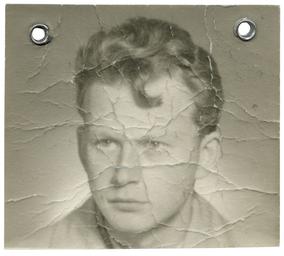Rudolf Volráb
1933 Born on 5 April in Košice. In the late 1930s, the Volrab family moved to the city of Slany, the mother's birthplace, where Rudolf enrolled at the local grammar school. 1949-1952 Studied at the Specialized School of Glassmaking in Kamenicky Senov. 1952-1961 Studied in the studio of Josef Kaplicky at the Academy of Arts, Architecture and Design in Prague. 1960 Married Libuse Šilhavá, whom he had encountered both at the school in Kamenický Šenov and the Academy. 1961 Moved to his first studio in the Nový Svět neighbourhood in Prague Hradčany. His son Marian was born. Held his first solo exhibition in the E. F. Burian Theatre in Prague (with Jan Hendrych). 1963-1965 His works became dominated by informal morphology and a dark colour scheme. 1965 His daughter Monika was born. 1966 "A creative turning point": Volráb began laying emphasis on expressive lines and a bright colour palette and his main subjects became heads and figures and their fragments. 1966-1967 At the turn of the two years, moved to a new flat with a studio in the Prague neighbourhood of Spořilov. 1969 Participated in the second symposium "Artchemo" in Pardubice. Rudolf Volráb died on 4 October in Prague in an unfortunate accident.
Similar to many of his contemporaries, Rudolf Volráb underwent a period of informal morphology, creating dark structural paintings with a surreal subtext which, nevertheless, corresponded to and in no substantial way differed from the unofficial topical production of the first half of the 1960s. The change brought to Volráb's style in the mid-1960s resulted in an emancipated figure, often merely a head, and in the domination of an expressive drawing line, distinct colour palette and, simultaneously, nearly sculptural feeling of space, although the latter was constructed on colour structure instead of classic geometry. The post-1967 period resulted in a series of paintings and drawings of radical colour scheme where the human body or its parts were turned into almost amorphous structures whirling through an undefined space. Especially Volráb's drawings from this time display an infinite transformation of the figure, its variations, multiplications and deformations, its motion revolving around a single point or its unexpected enclosure in a firm structure. The restless drawing was then also transposed to paintings and large-dimensional works on paper, supported by catching colour modulation and colour interrelations (the use of non-complementary colours or a wide range of pink nuances on the verge of referring to corporeality, evoking primary human experiences). Volráb gradually loosened himself from the two-dimensional painting surface and came to integrate various methods to open his works into the space, such as cutting through, layering, deforming, adding and interlinking. And although the figure retained its presence in only a latent form, exactly these works have a very strong physical character. The invitation to “Artchemo” and discovering epoxide resin as a material new to him allowed Volráb to realize some ideas hitherto present in his drawings – mainly to fuse several solutions of a single motif, often heads, already conceived as a bearing sign. Volráb's works based on serial arrangement and multiplication of an isolated feature were frequently interpreted as an early Czech response to American Pop Art, even though his points of departure are totally different and rather link together the individual stages of a hardly noticeable motion. All works radiate a sense of disquiet, which is also given by the artist's utter indifference to a conscious compositional solution of the painting surface, and some nervous tension, as is also apparent from the artistic gesture consisting of swift drawing or wild painting expression.
(Taken from the Summary of the monograph: Rudolf Volráb (1933−1969)





